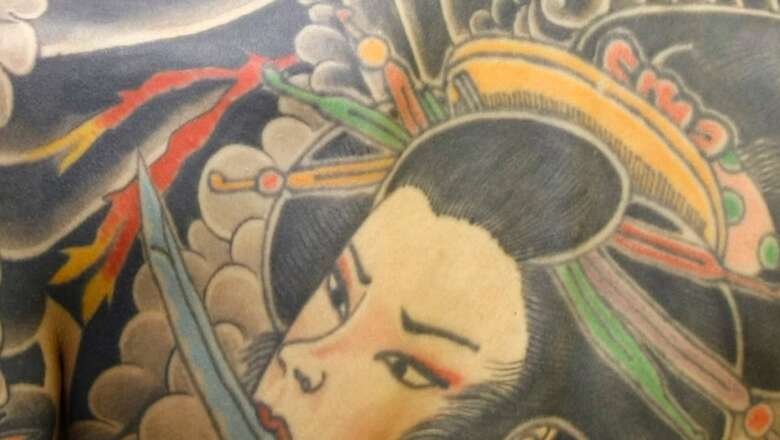
views
Nishimura Mako is a petite woman in her late fifties, with flowing hair and a delicate face. But you soon notice that she is no traditional Japanese lady – she is tattooed up to her neck and hands and her little finger is missing. These are signs of affiliation to the yakuza – Japan’s notorious criminal syndicates.
The yakuza is dominated by men and leaves only informal roles to women. Typically a woman involved with the yakuza might be an anesan, a boss’ wife who takes care of young affiliates and mediates between them and her husband. Wives and partners of the members support the group in a peripheral way. Some get involved to the extent that they manage yakuza-owned clubs or deal drugs.
When I interviewed Nishimura recently as part of my research, she told me that when she had become involved with the yakuza at 20, she took up both roles. But she went one step further – Nishimura is the only woman who has ever partaken in the sakazuki ceremony of exchanging sake cups. This is the ritual that confirms formal affiliation with a yakuza group.
Joining the gang Born into a rigorous family of government officials, Nishimura’s childhood was strict. Her memories revolve around her authoritarian father and the bamboo stick he would use to discipline her. During junior high school, she felt the urge to escape from under the yoke of her family, so she befriended unruly peers – and eventually biker gangs (bōsozoku) who taught her how to fight.
This rebellious streak led her to a young yakuza member, who took her under his wing and showed her how to collect protection money, solve disputes, engage in blackmail and scout girls for prostitution. Her life took a turn when one night she received a call: her friend was in a fight and needed help. She ran to the rescue and using a club she turned the scene into a bloodbath. This caught the attention of the boss of the local yakuza group, who called her to his office. She told me that she remembers his words to this day: “Even if you’re a woman, you must become a yakuza”.
she had been to juvenile detention centres several times, and her family had ceased their efforts to save her. She accepted the boss’ invitation and started living the rigorous life of a yakuza trainee. She joined alongside a cohort of male recruits, performing daily tasks, and eventually taking part in the group’s criminal activities. Master of finger cutting She finally underwent the sakazuki ceremony dressed in a male kimono, and swore her life to the path of the yakuza.
As an affiliate, she ran prostitution and drugs businesses, collected debts and mediated disputes between rival groups. When she cut off her own little finger to apologise for a collective mistake in a ritual known as yubitsume, she realised she had a knack for it. Members who could not go through with the amputation themselves would ask Nishimura to do it for them, garnering her the nickname of “master of finger cutting”.
But disillusionment set in once Nishimura reached her thirties, as meth became the main trade of her group and her own addiction started taking a heavy toll. She ran away – ironically continuing to run her meth business independently. For this, she was expelled from the group. At this point she started a relationship with a member of a rival group, and a pregnancy prompted her to cut ties with the yakuza world in exchange for a quiet life raising her child.
But, despite her efforts, her yakuza past – marked by her tattoos – prevented her from getting any regular sort of job. She married the father of her child, now a yakuza boss, and returned to prostitution businesses and drug dealing. After a second pregnancy, fights with her husband became more and more violent, to the point police were called any time one erupted. They eventually divorced and he took custody of the two sons. She rejoined her old group, but meth had changed the boss that she adored, and in two years she left for good.
Life after crime Nishimura lived as a male yakuza and retired as one. She found a job in the demolition business and a modest home where she now lives alone. She lives a quiet life, trying to be accepted by the community and to help others. With the assistance of Mr Fujimoto, a former yakuza himself, she also manages a branch of Gojinkai, a charity dedicated to providing housing and aid to former yakuza members, ex-convicts and addicts.
She says, “My day is not complete if I don’t come here at night”. They gather around a table to talk about the old days, current difficulties, and to check on each other. She is still the only woman at the table. She insists that what earned her respect in an all-male world is her capacity for violence: “I was great at fighting, I never lost against a man”. But Nishimura does not want to be a feminist icon: it was not her intention to break gender stereotypes or publicise herself as the only female yakuza.
There have been other women – like Taoka Fumiko, widow of a yakuza boss – who, though not formally affiliated, have made a significant impact in the history of the yakuza. But none went the extra step like Nishimura and became a fully pledged member with the cut little finger. Her story redefines the boundaries of gender roles and allegiance in the brutal world of Japanese organised crime – a unique journey of identity and belonging.
(The Conversation)


















Comments
0 comment